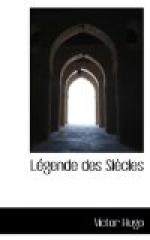burg (German), a castle.
guivre (also written givre), a heraldic term meaning a serpent.
dree, a fantastic stone ornament.
fohn (German Foehn), the south wind.
le Grand Dormant: Frederick Barbarossa, who, tradition says, never died, but is still sleeping in a cave.
roture, i.e. his position as a peasant. Roture is derived from the Latin ruptura, the action of breaking the earth, and is the base of the common word roturier.
releve, used in its feudal sense of ‘to hold of’; the castle was not feudally dependent on the city.
L. 214, i.e. the castle reflects the history of the ancient kings.
les deux haches de pierre. This is said figuratively and alludes to the deeds of Attila, who ravaged the Eastern Empire and extended his dominions almost to the Ural Mountains, whilst later on, crossing the Rhine, he attacked the Goths of Southern France and Spain.
Lusace, Latin Lusatia, German Lausitz, was a district between the Elbe and the Oder, in what is now the kingdom of Saxony. But the name has no significance. The personages and places in the poem are in reality all imaginary.
la griffe is the claw of a beast or bird of prey; la serre is the foot of a bird of prey.
Sortent de leur tenaille. A somewhat obscure expression. Apparently tenaille is used in the sense of ‘vice’, and the words mean ‘are of their manufacture or moulding.’
L. 291. i.e. the Emperor is the superior in rank.
dromons. See note on AYMERILLOT, L. 39.
l’ordre teutonique, the Order of Teutonic Knights. Originally founded to protect the Christians in Palestine, the Teutonic Knights received domains in Italy and Germany from the Pope and Emperor, conquered Prussia (1228), and established there a military power which lasted four centuries.
hydre. In Greek legend the hydra was a serpent with seven heads, and, when one of them was cut off, two grew in its place. It is Hugo’s favourite figure for cruelty or tyranny.
Lusace consisted of two margraviates, the upper and the lower.
elle a peur du fleuron, i.e. she is afraid to be marchioness. The flower-shaped ornaments in a crown are called fleurons. A marquis’s coronet was adorned with ‘fleurons’ alternating with pearls and the contrast between the pointed ‘fleuron’ and the round pearl suggests the figure employed in the next line.
tribunaux d’amour, or cours d’amour, were the celebrated courts of the Middle Ages, presided over by ladies of high rank, which gave judgement in cases of love and gallantry and laid down laws for lovers. They existed principally in France, especially in Southern France.
L. 369. The Wends were a Slav people who lived in Lusatia, but the name Thassilo is Bavarian.




